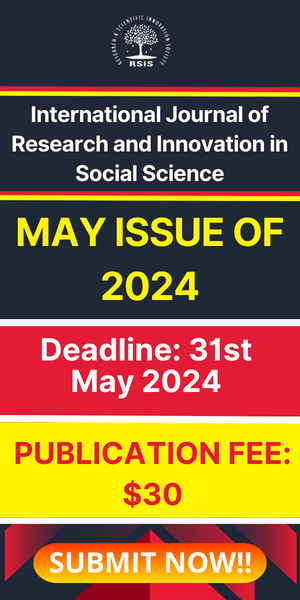- March 21, 2022
- Posted by: rsispostadmin
- Categories: Guidance and Counselling, IJRISS, Social Science
International Journal of Research and Innovation in Social Science (IJRISS) | Volume VI, Issue II, February 2022 | ISSN 2454–6186
Relationship Between Learning Styles And Mathematics Academic Achievement Of Secondary School Students In Awka Education Zone.
Ada Anyamene; Princewill Ikechukwu Odalonu
Department of Guidance and Counselling, Nnamdi Azikiwe University, Akwa, Anambra State, Nigeria
Abstract
Academic achievement of students occupies a very important position in learning process, thus, understanding its relationship with student’s learning style preference is an important consideration when designing classroom instruction. This study determined the relationship between learning styles and students’ Mathematics academic achievement in Awka Education zone, Anambra State. The study adopted a correlational research design. A multi-stage sampling procedure was adopted and used in selecting a sample size of 1,241 students from a population of 6,279 students in public secondary schools. A validated questionnaire titled, Learning Style Questionnaire was used to collect data for the study. The questionnaire has reliability coefficient alphas of 0.68, 0.64 and 0.77 on each of the learning style cluster. The questionnaire was administered through direct delivery approach. Data was collected and analysed using percentages and Pearson Product Moment Correlation Coefficient. Findings from the study revealed among others that; there is very low negative relationship existing between the secondary school students’ visual learning style and their achievements in Mathematics in Anambra State; there is very low negative relationship existing between the students’ auditory and kinesthetic learning style and their achievements in Mathematics in secondary schools. Similarly, the findings revealed that the relationship existing between the secondary school students’ visual, auditory and kinaesthetic learning style and their achievements in Mathematics is not significant. Based on the findings, the following recommendations among others were made that teachers should take into account their students ‘diverse learning styles in order to design instructional methods that take care of those diversities and remain sensitive of such during the instruction process.
Keywords: Learning Styles, students, mathematics, academic achievement, relationship
INTRODUCTION
Academic achievement of students has often been used as a criterion to determine the outcome of teaching and learning. Hence, it is seen as a criterion to judge students’ total potentiality and the extent to which the individual is likely to attain in life. Academic achievement of students also occupies a very important position in education, as well as in learning process. Thus, the issue of students achievement in school is thus important to many, including parents who care about their wards’ academic achievement because they believed that good academic report will provide better career choice and subsequently, job security.
However, it has been observed that there is a decline in the standard of education in the country (Aremu, 2005). This decline tends to affect the overall academic achievement of secondary school students. As Okonkwo (2012) observed, it has remained on steady decline, especially core subjects like Mathematics and English Language thereby leading to an overall poor academic achievement among students in Nigeria.
Using the May/June 2017 secondary school certificate examination results for example, out of 1,471,151 candidates that sat for the examination and whose results were released, 923,486 candidates, representing 59.22 per cent, obtained credits in five subjects, including English Language and Mathematics (West African Examination Council, WAEC, 2017). Although the general performance is an improvement from the examinations pass rate in 2016, which stood at 52.97 per cent, however, the downward movement in the performance of states like Anambra which went from being in the second position in the preceded year to 6th position in the 2017 May/June examination.


